Contents
There are many ways to deal with cobwebs on an apple tree in spring. At the beginning of the season, chemicals are used for this. They are also used for prevention in late autumn or early spring. At the fruiting stage, it is worth using only biological insecticides or folk remedies. Agricultural practices will also help.
Why is the apple tree covered with cobwebs
The web on the branches of the apple tree appears for various reasons, and almost always they are associated with pests. Some of them are microscopic in size and are not visible to the eye (for example, spider mites). Others can be seen even from afar (caterpillars, leaf rollers). The main pests that cause webs in the spring are described below.
apple moth
This is a butterfly, which is also called an ermine moth. Caterpillars weave cobwebs on apple trees in spring, which are especially dangerous for fruit crops. They adapt well to different climatic conditions, are protected from the cold thanks to special shields and are activated with the onset of heat.
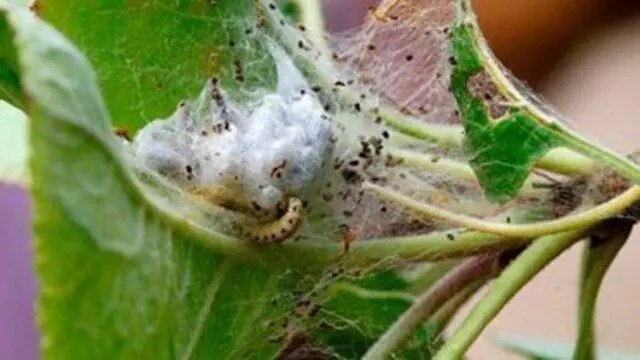
Caterpillars actively feed on young greens for 4-6 weeks, which is noticeable by gnawed, twisted and drying leaves.
After that, the pests pupate, weave a nest from the web and settle there. After another two weeks, a butterfly with silver wings appears. She lays many eggs on the bark of young shoots, from which the larvae will hatch again, and the cycle will repeat.
Moth does a lot of damage. She not only spins a web in the spring, but also destroys young greens and shoots. If the invasion is large, young seedlings may even die. This is due to the fact that due to damage to the leaves, photosynthesis processes are disrupted, and the trees survive the winter worse.
spider aphid
There are several varieties of aphids, including spider webs. It gets its name from the fact that it forms cobwebs on leaves and young shoots in spring as well as in summer. It is difficult to notice it visually, since the size of the body is small.
Most often, aphids appear along with the spider mite. This is a dangerous pest that feeds on plant juices. You can determine the invasion not only by the web, but also by the foliage. It swells, the color becomes yellowish, after which the leaf plates dry.
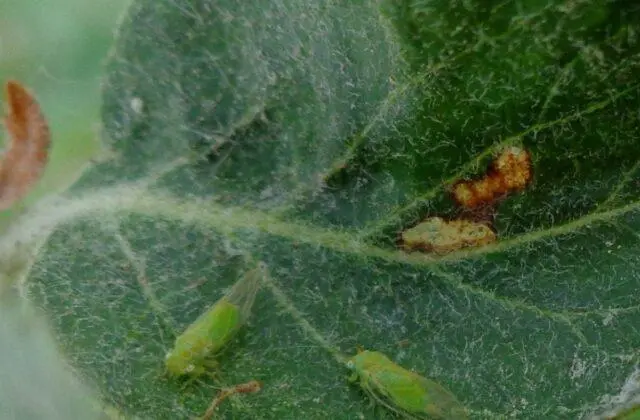
Webs can form due to aphids
ringed silkworm
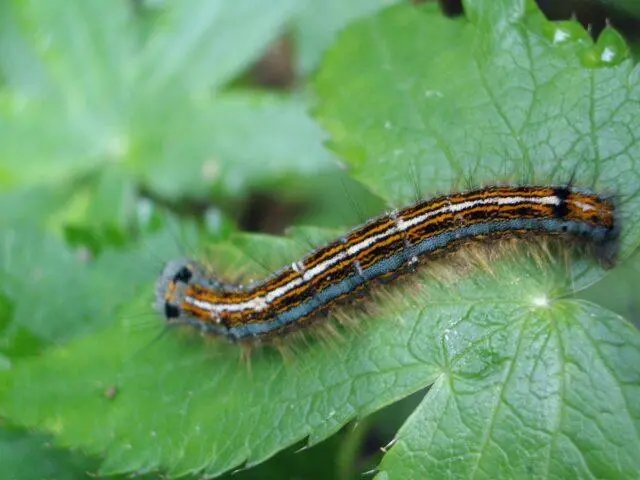
Harm is caused mainly by caterpillars
The cobweb on the leaves of the apple tree also appears in the spring because of the ringed silkworm. They are butterflies with greyish-cream wings and are also often referred to as ringed cocoonworms. Individuals are divided into females and males, the latter being noticeably smaller. Coloring can be either lighter, with brown tints, or darker.
The caterpillars are quite large, reaching a length of 5-5,5 cm. The body is covered with blue, white or orange stripes, there are bristles characteristic of the silkworm. The invasion begins in the spring during the swelling of the kidneys. Caterpillars massively destroy young foliage and shoots, form large clods of cobwebs.
Butterflies also harm apple trees – they lay eggs in the form of rings on young thin branches. After a few days, brown caterpillars emerge from them. All daylight hours they do not make themselves known – they remain motionless. And at night they begin to intensively feed on leaves and flowers, leaving a web. Young greens are affected in the spring, because of which the apple tree can be seriously damaged.
winter moth
This is a brown-gray butterfly with underdeveloped wings, which is why it does not fly. The insect is extremely harmful – the invasion of moths destroys a significant part of the leaves on the apple tree in spring, up to half.
Males are light grey, their wings have rounded edges. They eat leaves and leave webs in spring and summer. The danger is that insects can withstand temperatures down to -15 degrees. They lay their eggs under the bark, on the branches and at the base of the buds, even in winter. Pests are activated in the late afternoon, when the heat subsides. They are also active at night.
A few days later, green-yellow caterpillars appear, their body has a dark stripe along the back. They feed on young buds and green leaves. They actively develop for four weeks in a row, weave a web along the leaves and descend along it to the soil. Then they pupate, climb underground and live there until autumn.
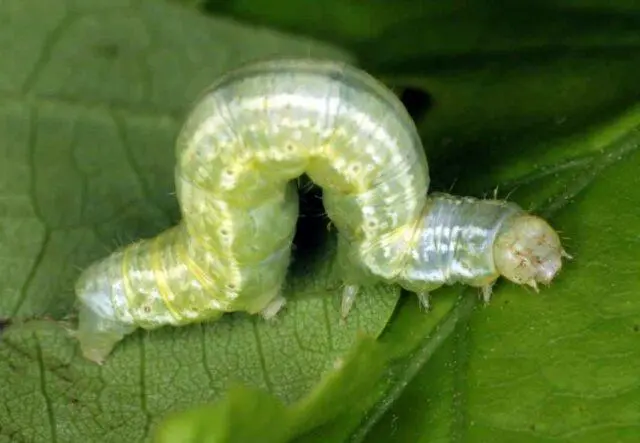
The caterpillar of the winter moth is capable of destroying the entire crown of a young tree
apple sucker
This is a psyllid with a greenish body and transparent wings, the length of which does not exceed 3 mm. They feed on the leaves of the apple tree. By the end of summer they darken, lay their eggs under the bark and at the base of young buds. In the spring, larvae hatch from them, after which they again feed on buds, greenery and even young bark.
They secrete a sticky, sweet liquid called honeydew. It kind of resembles a web. Dew pollutes the surface and promotes the spread of insects, as well as the dangerous soot fungus. You can determine its appearance by the following signs:
- blackening of the trunk, foliage, as if they were covered with oven soot;
- plaque is easily wiped off with fingers or a wet cloth;
- leaves turn black and dry out.
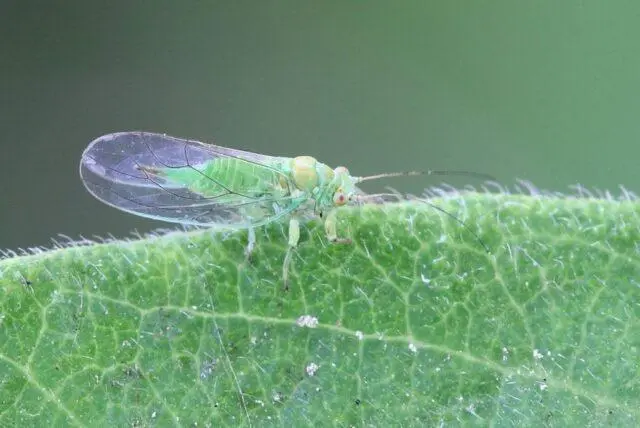
As a result of the vital activity of the sucker, the apple tree lags behind in development, the fruits are covered with black soot, and it is unpleasant to eat them.
The immunity of the plant is weakened, the yield is reduced.
spider mite
Another common reason for the appearance of cobwebs on an apple tree in early spring is a spider mite. It is a small arthropod belonging to the arachnid family. He is not an insect. The pest affects fruit, berry, ornamental, vegetable, flower crops, and it is found everywhere in temperate regions.
It spreads especially actively if dry and hot weather without rains is established in spring or summer. At this moment, you can notice how the cobwebs are covered not only with shoots and foliage of apple trees, but also with other trees, as well as shrubs.
It is difficult to visually notice the tick, because its body is microscopic in size. But you can determine the invasion by external signs:
- gossamer on the back of the leaves, on the shoots;
- the inner surface of the leaf plates becomes white;
- spots of a silvery, cream or scarlet hue appear on the outside.
Apple codling moth (leafworm)
The codling moth is a common pest that leaves cobwebs on the apple tree in spring. Lays eggs on the outer side of the leaf. Two weeks later, small pink caterpillars appear from them. This time just falls on flowering – pests actively feed on buds and unblown buds.
After the formation of pupae, the leaf plates are folded into a tube, and then overgrown with cobwebs, which is noticeable in spring and early summer. The pest is very common, so it is better to deal with it as early as possible. First, insects are removed manually, then the bark is cleaned and treated with biological insecticides or folk remedies.
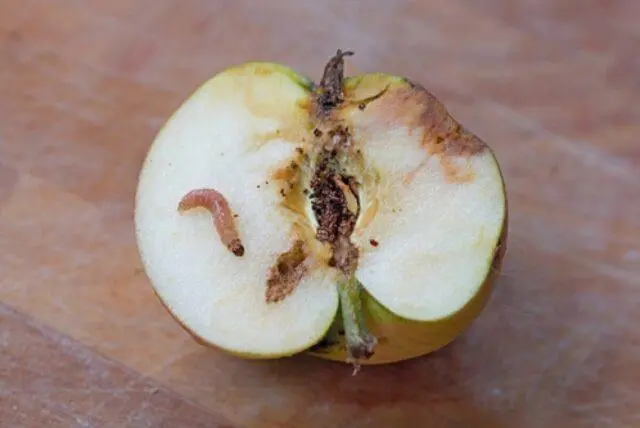
Codling moths destroy crops
Hawthorn
A web on a young apple tree in spring may also appear due to hawthorn. It is quite large, so visually this insect is easy to notice.

Butterflies do not cause much harm, caterpillars are the most dangerous
They are green-brown, blending into the background. They feed on young leaves, roll them up and cover them with cobwebs. Nests hang on the branches, which are easy to find in the spring, collect by hand and burn. If this is done in a timely manner, the invasion can be avoided. Otherwise, the caterpillars will spread en masse, will feed on buds and buds.
Unpaired Silkworm
This is a butterfly with a light brown body and wings. It is characterized by exceptional fertility – in one clutch there are several hundred eggs, often up to 1000.

Caterpillars develop in a few weeks, hatch, and begin to feed on young shoots and foliage, spreading throughout the garden
They form a web, destroy leaf plates, then pupate. Then there are butterflies of clearly different sexes. Females have a thick cylindrical abdomen and white wings. In males, the wings are light brown, the patterns are dark, and the abdomen is noticeably thinner.
Both those and others are activated in the evening. Males mate with females right on the apple tree. After that, the latter lay their eggs under the bark, and the cycle repeats again.
What to do if a web appeared on the apple tree
If pests are found, you need to carefully examine the tree and remove the insects manually, and then carry out a total treatment. For this, folk remedies are used, but if their effect is insufficient, chemical preparations are also used. During fruiting, it is desirable to use biological agents. Usually pest control is carried out in a complex manner, therefore, the agricultural practices described below are also used.
Folk remedies
If, due to caterpillars on branches or other pests, the apple tree is in the web, it can be treated with folk remedies. These are natural solutions or decoctions based on plants, soda, wood ash or other compounds. The main recipes are:
- infusion of tobacco dust or wood ash 300 g in 10 liters;
- water infusion of nettle, celandine (500 g per 10 l);
- a decoction of marigold flowers (the same amount) or onion husks 300-400 g per 10 liters and others.
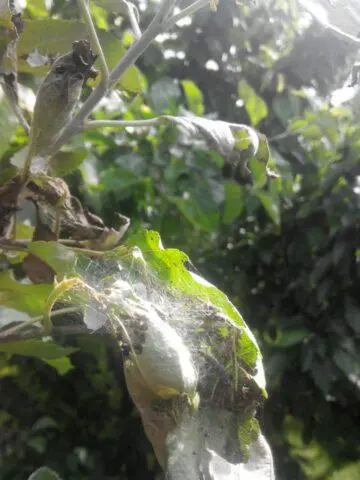
To eliminate pests that leave a web, you can use home methods
Chemicals
The most effective way to kill insects that cause apple trees to become covered with cobwebs in the spring is chemical insecticides. Among the effective means are the following:
- “Aktara”;
- “Decis”;
- “Insegar”;
- Omayt;
- “Fufanon”;
- “Match”;
- “Koragen” and others.
Biopreparations
Biological preparations differ in that they do not contain chemicals, but strains of bacteria or other microorganisms that destroy insects. To get rid of cobwebs on apple trees in spring and at other times of the year, it is recommended to use the following tools:
- “Bitoxibacillin”;
- “Entobakterin”;
- “Verticillin”;
- “Bicol”.
Agricultural practices
To combat insects that leave webs on apple trees in the spring, conventional agrotechnical methods are also used:
- digging the trunk circle;
- mulching;
- trunk whitewashing;
- bark processing with garden pitch;
- pruning in early spring.
Processing time
To reliably protect the apple tree from pests that weave webs in the spring, trees and seedlings need to be processed several times per season:
- Until the bud breaks. When stable warm weather is established (from +10 during the day), insecticide treatment is carried out.
- After all the buds have blossomed, re-spraying is done.
- During the flowering period in spring, the trees are carefully examined, cobwebs and other signs are found, and caterpillars and other insects are manually removed.
- At the fruiting stage, processing is done as needed. I use only biopreparations or folk remedies.
- Finally, after dropping the foliage in the fall, the last spraying is carried out. This is a preventive measure to prevent the appearance of cobwebs on the apple tree next spring.

Processing is carried out several times before and after flowering.
preventive measures
Since it is often not so easy to get rid of insects that leave cobwebs on an apple tree in spring, it is better to prevent the invasion of pests. To do this, you can use the following measures:
- timely destroy weeds;
- do not plant apple trees next to cruciferous;
- periodically feed the trees;
- be sure to remove all fallen leaves in the fall and take them away;
- carry out regular pruning;
- close hollows;
- treat wounds with garden pitch;
- remove root weeds.
Conclusion
There are several ways to deal with cobwebs on an apple tree in the spring. The work should be comprehensive – spraying with drugs, observing prevention, digging up the trunk circle, timely pruning. It is important to understand that the invasion can be very strong. Therefore, it is necessary to regularly inspect the trees and proceed with the destruction as early as possible.









